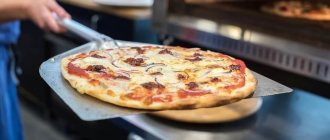Pizza is one of the most popular dishes in the world. It’s probably not so easy to find a person who doesn’t like pizza. In essence, it is nothing more than a hot sandwich, the dough base of which is baked together with a filling (“topping”) placed on it, made up of various products.
Pizza preparation technology provides that the dough can be used in a variety of ways during the cooking process. The main thing is that it is in harmony with the selected contents of the dish. The choice and preparation of pizza dough, as well as the toppings, always depend on the cook’s own taste and the availability of the necessary products. The unlimited breadth of choice of possible ingredients provides scope for culinary creativity, allowing you to prepare an endless variety of pizzas to suit every taste. This explains the enormous popularity of pizza all over the world.
Story
There is a well-known legend that the first recipe and technology for making pizza was spread by Roman legionnaires returning from Palestine. The dish was called “pisea” and was a piece of unleavened bread with various vegetables laid out on it. Other sources claim that the Greek "plakuntos" was modified by the Romans. Among other things, cheese was added to it.
The historian Cato the Elder in his works mentions that the Romans baked pizza - “a flat circle of dough greased with olive oil” on hot stones, covering it with honey and herbs. Over the past centuries, pizza making technology has hardly changed. It still requires a special approach, although the dish is prepared quite quickly.
Selecting a location
Choosing a “bread” location with high traffic volume is one of the main keys to the successful running of any business. In order to place one machine, you will need an area of no more than two square meters. The main point to consider before installation is the availability of a reliable power supply.
15
Podcasts: do businesses need them?
Before choosing a location, decide on the target audience you will be counting on. It has long been clear that pizza is loved mainly by active young people. The age of the audience ranges from 16 to 30 years old, maybe a little older. You need to count on employees of nearby offices, as well as tourists and students.
Thus, you can most advantageously locate a pizza machine near the following establishments:
- Universities and areas nearby;
- business centers;
- car washes;
- gas stations;
- parks and recreation areas;
- airports;
- railway stations;
- stadiums;
- cinemas;
- hotel complexes.
If you have the opportunity to install a hot drinks machine next to the pizza machine, this will significantly increase your sales level. Of course, for entrepreneurs living in large cities, there is always one problem: all the best places, as a rule, are already occupied, but if such a point can be found, the price for renting it will range from 3 to 4,000 rubles monthly. In a large shopping center, such machines are allowed to be installed for a payment of 6,000 rubles or more.
Italian pizza: dough preparation technology. Preparing the yeast base
This recipe is classic. You don’t need any special skills to master it; the set of ingredients is also quite accessible and simple. The pizza manufacturing technology involves the use of:
- Wheat or bread flour - the gluten contained in it gives the dough elasticity and the ability to rise.
- Dry yeast. They should be diluted with warm water in a bowl, which is recommended to be heated in advance.
- Eggs. Their number depends on the personal preferences of the hostess.
- Sugar, salt and olive oil.
Adviсe
Experienced housewives recommend preparing pizza dough one and a half to two hours before baking - it takes time to rise. When using a round shaped treat for baking, you must thoroughly grease it with vegetable oil and sprinkle with semolina. This will make it easier for the pizza to come out of the pan. Before placing the pizza pan in the oven, it is recommended to place it in a warm place for 15 minutes. To obtain an appetizing crust on the surface of the dough, experts recommend first placing the dough without filling in a preheated oven. This way the special taste of the pizza is achieved.
Cooking according to the cooking technology (the number of ingredients and the sequence of actions must exactly correspond to the instructions) guarantees a successful result. The thickness of the dough depends on how it is rolled out.
Stages
All products should be mixed; many housewives recommend using a mixer for this. The dough is rolled out immediately. You can prepare it:
- In a frying pan. To do this, the rolled out dough is placed in a heated frying pan with hot vegetable oil. The filling is placed on top. Housewives recommend covering the frying pan with a lid. To ensure that the pizza bakes evenly, the heat should be kept to a minimum. The undoubted advantage of cooking a dish in a frying pan is the minimum time required: the process takes about 15 minutes.
- In the oven. Thin crust pizza is baked in the oven in the same way as yeast pizza. This reduces cooking time. The base, made from yeast-free dough, is baked in half an hour.
- In a steam bath. This method is used to prepare diet pizza for people who cannot eat baked and fried foods.
Many centuries passed before pizza won universal popular love. If Italian pasta in ancient times was considered the food of the elite, then pizza is “a product of the people” and has always been considered the lot of the poor. However, it is to the lower circles of society that pizza owes its huge number of recipes (more than 3,000!) and, best of all, its preparation methods are becoming more and more numerous.
The pizza recipe is quite simple, but still, you should not speed up or slow down the process of its preparation because of this.
Making pizza at home is not difficult. To do this, you will need a frying pan with a thickness of more than 2 mm or a baking tray, which must first be greased with vegetable oil. If the pizza is planned to be sweet, then in order to prevent the dish from burning, the baking sheet is greased with cooking oil or simply sprinkled with flour.
The base crust of the pizza does not have to be very thin; it will be enough to place the dough on a baking sheet or frying pan and stretch it with your fingers over the entire area of the pan.
Before sending it to a heated oven or oven, the dough of the future pizza should “rest” a little, approximately 5-7 minutes. To ensure that the finished pizza does not stick to the bottom, the inner surface of the baking sheet or frying pan is well greased with vegetable oil, you can add a little semolina.
Pizza baked in the oven
If you correctly follow the pizza preparation technology, then before putting the filling on the dough, it must be pre-baked in such a way that a thin crispy crust is formed on the outside, and the dough remains raw on the inside. On average, it takes about 30 minutes to prepare a thin crust (with the exception of some types that require more time). A thick cake takes, accordingly, more time and is baked at a temperature of 220°C. Only after this should you add the filling and put the dish back in the oven.
The filling also has its own characteristics. The baking time for the pizza depends on what filling the pizza has (dry or liquid).
E
If the crust is thin with a dry or loose (fish, poultry, dry vegetables, meat, poultry, etc.) filling, then baking will take much less time than a pizza with a thick crust, which is best suited for pizza with a liquid or sweet filling. The liquid filling must be evaporated a little so that the cake does not become soggy. To do this, increase the baking time by 10 minutes and reduce the temperature in the oven.
When several types of filling are laid out on the crust, the bottom layers contain ready-made and dry products, and the top layers contain liquid or raw products.
For better baking of raw foods, the top layer of pizza is sprinkled with a thick layer of grated cheese. When the cheese melts and forms a crust, steam will form inside, which will speed up the baking process of raw foods.
Pizza baked in a frying pan
A frying pan has an undoubted advantage over a baking sheet for making pizza. Its main advantage is that the dough does not stick to the bottom. If you bake the crust in a frying pan with a transparent thermal lid, you will not need to turn it over to obtain an even crust. In addition, this method of baking pizza is the fastest. But, it is worth remembering that only pizza with a thin crust and dry filling can be baked in a frying pan, and the juicier products are laid out in the upper layers in order to saturate the lower dry ones.
Once the crust and filling are laid out on a hot frying pan, a lid is placed on top and the heat is turned to low. The pizza will be ready within 20 minutes. To be extra sure, as with all baked goods, you can pierce the entire dish with a match and if the match turns out to be dry, then the pizza is ready.
Pizza baked in a steam bath
There is another, rather unusual way of cooking pizza - in a steam bath. This option will be useful for people suffering from stomach diseases and avoiding heavy and fatty foods.
In order to cook pizza in a steam bath, you will need yeast dough mixed with eggs, which is aged longer than usual. The dough is rolled out in a thick layer and placed on a wire rack.
About the secrets of cooking
Experts believe that the main thing in pizza is the flatbread. Many people prefer pizza with thin crust. But recently, dishes made on thick dough have become increasingly in demand. The tortilla must be crispy and soft enough that it can be folded freely without damaging the crust. When preparing pizza dough, olive oil is used. It promotes better absorption of high-calorie foods.
The taste of pizza, as gourmets note, should not be monotonous; as you eat the product, the taste impression should change (from a cheese note to a tomato note, then to a spicy note, olive note, etc.). The taste of the ingredients is interrupted by nothing in the pizza. All filling ingredients must be absolutely fresh; this factor is important for shaping the taste of the dish.
To prepare classic pizza dough, special whole grain flour, yeast, olive oil, salt and water are used. The dough is usually kneaded by hand, and after proofing it is rolled out into a thin layer. Next, it should be covered with tomato sauce, after which almost any toppings should be added.
It is recommended to bake pizza in a special oven where the temperature is maintained at least 350 degrees. To bake classic pizza, a special wood-burning oven (the so-called Pompeian oven) is used, characterized by a hemispherical arch shape. In addition, the dish is prepared in convection and deck ovens.
Margherita pizza recipe
Today there are a great variety of pizza recipes. In modern cuisine, a wide variety of ingredients are placed on a dough flatbread - from vegetables and fruits to rare delicacies. To prepare Margherita pizza, one of the most famous versions of the dish, use:
- flour - 400 g;
- warm water - 350 ml;
- yeast (dry) - 15 g;
- olive oil - 50 ml;
- sugar - 1 tbsp. l.;
- salt - 1 tsp;
- tomato sauce - 150 ml;
- mozzarella cheese - 200 g;
- parmesan cheese - 70 g;
- olive oil - 2 tbsp. l.;
- basil - 2 stems.
Special oil dispensers
In fact, this is a standard oil jug with an elongated front spout. Most often on sale you can find a metal vessel with a familiar copper dispenser. This is an indispensable attribute in a professional kitchen. But at home you can do without it.
However, if we are talking about TOKYO-CITY restaurants that deliver pizza to St. Petersburg, then, you will agree, it is difficult to imagine a professional kitchen without a butter jug with a special dispenser.
Preparation
Pour water into a large bowl, add yeast and leave for 5 minutes. Once the mixture begins to foam, add sugar, butter and salt. Constantly whisking the mixture, gradually add flour until a sticky dough forms. Leave the dough for 1 hour. The bowl should be covered with cling film. After the dough has risen, place it on a floured work surface and begin kneading until the surface becomes smooth.
Next, roll out the dough and place it on a baking sheet, which is pre-greased with olive oil. The oven is heated to 250 degrees. Mozzarella is cut into small cubes, Parmesan is grated. Tomato sauce is spread over the surface of the dough, cheeses are placed on top, and garnished with basil leaves. Don't forget to spray the product with olive oil. The pizza is baked in the oven.
Traditional classic pizza is cut with a special knife before use (into pieces in the amount of 4, 6, 8, etc.). They eat pizza with their hands.
Equipment selection
There are several types of pizza machines. If we are talking about simple equipment, it has a refrigerated compartment for storing the finished dish, which only needs to be heated and given to the visitor. More complex designs reproduce the entire technology of preparing the product from start to finish. They “know how” to knead the dough, and all the components in them are sorted into different blocks. When the cooking process begins, the ingredients are mixed together.
We also recommend reading:
How to make money by delivering ready-made meals? Why is it more profitable to buy an apartment on the secondary market? Dog walking: how to organize a business? Hotel for pets: how to create your own business?
A simple machine that heats ready-made pizza costs about 300,000 rubles, and an “advanced” one will cost the owner twice as much. You can purchase equipment from both Italian and Russian manufacturers. For example, from the Italian company Lets Pizza you can always purchase a full-fledged machine that can prepare pizza according to four recipes. After accepting the order, flour and water are mixed in the drum, after which they are pressed. The machine covers the base with tomato sauce, adding filling and cheese. Cooking takes place in an infrared oven, and the buyer receives the finished product on a tray made of thick cardboard. The duration of this process is about three minutes.
One of the advantages of such a pizza maker is that it is equipped with a transparent window through which visitors can observe all stages of the preparation of the dish.
9
We invest profitably in Internet projects
Cheaper brand models are:
- Q-pizza;
- Wonder Pizza;
- "Shcha."
They just work with chilled workpieces placed in a special unit during storage from 2 to 60°C. After the visitor places an order, the machine sends the product to the oven, cooks it at high temperature and “gives it” through the tray.
When choosing a pizza machine, you should focus on the initial amount of money and a number of nuances:
- buy only the model that “knows how” to pack ready-made pizza;
- production must be of good quality;
- It’s better if the machine is beautifully and brightly painted. This will attract the attention of visitors and will serve as additional free advertising;
- the instructions on the machine must be written in Russian so that visitors do not get confused with the buttons and can perform all the actions themselves;
- Buy equipment with acceptors for bills and coins, as well as the ability to make cashless payments using a card.
Every pizza machine must be equipped with a cash register that issues receipts. Since 2020, owners of vending machines are required to install an online cash register and send receipts to the tax authorities.
12
When you choose a pizza machine, think about how you can modify the terminal in it. The cash register is subject to mandatory registration, as well as the conclusion of an agreement with the OFD for the transfer of checks. It is better to choose a company that will not only install the equipment for you, but will also be ready to further assist with its maintenance and repair.
Main course in an Italian restaurant
The menu of every self-respecting establishment specializing in Italian cuisine necessarily includes a varied selection of pizzas. A full-fledged pizzeria is a special object of the food industry, with which, in a certain sense, other restaurants and cafes cannot compete. Establishments whose menu includes pizza, unlike classic pizzerias, have a minimal set of special equipment, much of which has been replaced by manual labor. But, although they say that the best equipment for pizza is the soul and hands of the master, without equipping the establishment with high-quality professional equipment, it is unlikely that it will be possible to accurately observe all the subtleties of pizza production technology.
The first Russian vending machine for baking and selling pizza has been developed
04.08.2009
(EROP) and ESFOR developed the first domestic vending machine for baking and selling pizza.
The device is an automatic mini-pizzeria, called the fashionable word “pizzamat”. In just two minutes and 100 rubles, the buyer receives a ready-made pizza of any of the 6 types available in the machine’s menu.
The pizza machine is designed for a maximum load of 120 pizzas. Pizza can be stored in it for 30 days at a temperature of +2 +6 degrees. It is baked at a temperature of 300 degrees. The filling for the machine (pizza) is supplied by the manufacturer himself. According to representatives of the EROP company, only natural products are used to prepare pizza.
Pizzeria equipment and production stages
The technology for preparing pizza in a pizzeria involves dividing the process into two stages: the production of semi-finished products (topping, i.e. filling and dough pieces) and baking of finished products. The equipment of a working area (pizzaiolo) in a restaurant is usually represented by a minimum set of equipment (flour sifter, dough mixing machine (dough mixer), proofing cabinet, vegetable cutter, slicer, stove for preparing sauces and a special oven. The flour sifter is used to clean flour from foreign particles and impurities, as well as to enrich it with oxygen necessary to increase the intensity of the dough fermentation process.
A dough mixing machine equipped with a spiral working element ensures optimal dough structure with a short kneading time. The presence of a proofing cabinet ensures proofing of yeast dough.
It is quite common to believe that hand-made dough is the best. But experts say that preparing dough in a dough mixing machine allows you to avoid overheating and achieve greater kneading uniformity.
When choosing a dough mixer, the owner of a pizzeria should first of all pay attention to the level of productivity and the capacity of the bowl. These parameters are directly dependent on the planned production volumes. After kneading, the dough is divided into equal parts and kneaded into flat cakes. When forming pizza crust in pizzerias, manual labor is traditionally used. Showcasing the skill of a pizza maker is believed to be attractive to customers. But the organization of large-scale production involves the use of such a unit as a dough press.
Pizzeria as a popular type of business
As you might already guess, pizza vending machines were invented by inventive Italians. Such machines can both sell ready-made pizza and prepare it on the spot. Thus, the concept of “vending culture” arose, which is now spreading around the world at tremendous speed. It is already known that a good pizzeria can not only recoup the expenses of its owner in the shortest possible time, but also seriously compete with even large pizzerias and other food outlets in the area.
vidtok
Thanks to the vending format, you, first of all, save on renting premises and get rid of all the hassle associated with it: repairs, interior decoration, design, utilities and constant problems with the sanitary and epidemiological station. You practically do not need employees who need to be paid monthly, because if you wish, you can learn how to independently service the device.
Pizza prepared in this way is cheaper than that purchased at a pizzeria, and frozen foods heated at work or at home cannot compete with it. Therefore, a product prepared in a pizza maker can confidently be called the “golden mean”, which will delight customers with a moderate cost and high quality.
Why is it sometimes not worth implementing business strategies that have worked for others?
Pizza ovens
Creating a quality product is impossible without using a professional pizza oven. Its main feature is the presence of a special stone surface that prevents food from burning and ensures stable maintenance of high temperatures.
There are 3 main types of pizza ovens:
- wood-burning (so-called Pompeii, using firewood and fuel briquettes);
- hearth (using gas or electricity);
- conveyor (using convection heating).
According to professionals, the process of baking pizza can be equally successful using both electricity and gas (although this option is considered more complex and problematic due to certification).
Wood-fired ovens are a great option for getting the perfect flavor from your baked goods. In ancient times, pizza was baked over fires using charcoal. Over time, they were upgraded to stone wood-burning ovens. The use of such ovens is associated with many financial costs and additional problems (installing ventilation, obtaining permits, etc.) Therefore, they usually try to install them in restaurants located outside the city. In establishments located within the city (ground floors of residential buildings, offices, shopping centers), experts recommend installing static hearth ovens (gas or electric). Their design simulates the baking processes in real Italian wood-burning ovens (the temperature in them reaches up to +500 degrees).
What is a deck pizza oven?
This installation is an economical option for a wood stove using electricity or gas. Its name is associated with the presence of a ceramic hearth inside, which is an analogue of the hearth in wood-burning stoves. The operating principle of the equipment is as follows: thanks to the action of tubular heating elements installed in the upper and lower parts of the working chamber, its temperature is brought to the required level.
The floor of the oven is equipped with a ceramic oven intended for cooking pizza. Baking is done directly on the surface of the hearth or in special forms that are installed on it.
Cooking pizza in a deck oven
The technology of baking pizza in a deck oven means that heating in the oven to make real Italian pizza on a thin base and with a minimum amount of filling should reach over 300 degrees. Only in this case will the product be elastic and have a crispy crust. Ovens equipped with a ceramic or stone hearth, providing the ability to regulate the temperature of the bottom and top surfaces, are the most successful option for baking such pizzas. For a long time, a fairly high temperature level is maintained in their chambers.
Using a thermostat, the oven is heated to the desired temperature (from 250 degrees). The pizza is pre-prepared, placed in a special form or placed directly under the oven. It takes about 6-8 minutes to prepare.
All the details of making the perfect pizza
A thin piece of aromatic pizza enters your mouth, begins to melt gently, and the crust produces a characteristic crunch. How nice it is to enjoy delicious food that makes you come back for it again and again. They say the most dangerous thing is not love, but habit. How can you create a product that will incredibly accurately “please” every visitor to your restaurant?!
First of all, you need to pay attention to the raw materials used. Flour, salt, yeast...how not to make a mistake in choosing? How to choose the right combination and dosage?
Flour
To make dough by long-term fermentation, specialized pizza flour with a high protein content is recommended, and the longer the fermentation (3 days or more), the more protein the flour should contain. When produced directly, using special flour with a high protein content will give a negative effect in the form of a rubbery crust.
The choice of flour for pizza production is influenced by:
- production process time;
- cold storage time for dough pieces;
- characteristics of the dough: it should be elastic and durable.
We recommend monitoring the quality indicators of flour, which you can find out at the mill where you purchase it. It is necessary to pay attention to W - an indicator of flour strength and P/L - an indicator of flour extensibility.
Flour strength (W) for perfect pizza:
- W: from 250 to 280 Flour for the production of bakery products using the direct method. Ideal for the production of pizza without long-term fermentation and storage (1 day in the cold at + 5°C).
- W: from 280 to 330 Strong flour, ideal for the Freezing technology. Also ideal for pizza with long-term storage (up to 3 days in the cold at + 5°C).
Flour extensibility index (P/L) at W not less than 280:
- P/L: 0.4-0.6 Ideal for pizza. The extensibility of the dough is greater than elasticity.
- P/L: 0.6-0.8 Suitable for pizza, but slightly difficult to roll out.
- P/L: above 0.8 Not recommended for pizza.
Yeast
According to established tradition, dry yeast is used to make pizza. We recommend using or Nevada® instant dry yeast . The dosage of dry yeast with direct technology is 0.5–0.7% by weight of flour; with long-term technologies, the dosage is reduced by two or more times.
Workshop temperature
The optimal room temperature for making pizza dough is 200 C.
Kneading
Once you have decided on the recipe, the fun part begins – kneading the dough. In pizza dough, intensive kneading at speed 2 is practically eliminated, because... this can lead to overstrengthening of the gluten, which will be reflected in the “rubberiness” of the finished pizza. The standard pattern is 10-12 minutes at low speed until the dough is rough. The final formation of the dough will occur during a long fermentation stage.
Temperature
For any technology, the optimal dough temperature after kneading is 18–200 C. To obtain this temperature, use cold water, ice water if necessary
Dough fermentation
For any technology, after kneading, a short fermentation is recommended—20–30 minutes in a workshop environment.
Dividing the dough
The dough is divided into pieces of the required mass and rounded. Afterwards, the balls are placed in oiled boxes and, depending on the technology, left in the workshop or placed in the refrigerator.
Approximate weight of workpieces:
| diameter | thin pizza | thick pizza |
| 25 cm | 210 g | 300 g |
| 30 cm | 300 g | 400 g |
| 35 cm | 410 g | 560 g |
Laying down
The main stage of preparing pizza dough. After rounding the blanks, the balls are subjected to resting for a period of several hours to several days, depending on the technology. As a rule, resting is done in plastic boxes, generously lubricated with oil. The blanks are placed in boxes at some distance from each other and covered. During resting, the dough will increase in volume, flavoring substances will accumulate, and the gluten framework will gradually begin to weaken under the influence of enzymes, which will improve the plasticity of the dough and make it easier to bite off the finished product. The depth of these processes directly depends on the time they take place, so the technology of long-term cold fermentation is preferable to the direct method when making pizza.
Molding
The correct temperature for shaping pizza dough is 18–20 C. At this temperature, the dough has optimal elastic-plastic properties—it stretches easily, does not tear or shrink. Before stretching, the workpiece is generously coated in the slap mixture. Next, depending on the type of pizza, a side is formed, and then the pizza is stretched, or the workpiece is stretched immediately if a side is not provided.
Slap mixture is a mixture of semolina and wheat flour in a 50/50 ratio. It is possible to use pure semolina; corn flour is also sometimes used. The mixture will determine the appearance of the pizza and the crispiness of the crust.
Proofing
For thin and traditional pizza, proofing is not provided; the dough for thick pizza (pan pizza) is proofed for 40-60 minutes in a workshop environment. The trays are stacked on top of each other to prevent weathering. When using the dough storage technology for more than one day, the trays must be moved from bottom to top for uniform fermentation of the dough.
One of the important points that distinguishes a good restaurant from a gourmet one is the menu, which is structured in such a way that the visitor cannot doubt his choice and find the option that he likes.
Applying the filling
Initially, the rolled out dough is actively pricked with a hedgehog roller, after which pizza sauce is applied to the workpiece so that it does not reach 1 cm from the edge of the pizza. Next, depending on the type of pizza, the components are sequentially applied to the area covered with the sauce.
Bakery
Produced in hearths or specialized tunnels at a temperature of 280–3200 C for 3–5 minutes. Pizza can be baked directly on the deck, but special mesh screens (screens) or pizza baking pans can be used, in which the pizza is baked in vegetable oil, which improves the crispiness of the crust, while making the dough itself more tender.
Experts recommend using no more than 10 types of pizza on restaurant menus: vegetable pizza (there should be one), with seafood (for example, only with shrimp and also separately with a “mix”), “Margherita,” “Pepperoni,” “Cheese,” “ Meat”, “BBQ chicken”, etc.
It is also worth paying attention to sauces, because they are an important component of pizza. Therefore, you need to choose several sauces for your pizzeria, but preferably no more than two. Most often it is “Tomato” and “Alfredo” or “White” sauce. In the modern world, you can buy ready-made or semi-finished sauce, or prepare it yourself.











